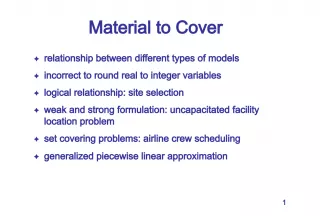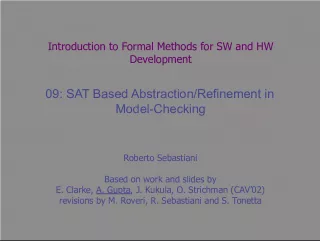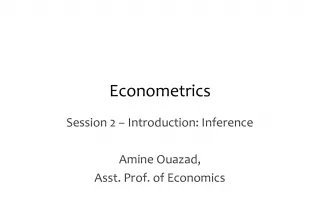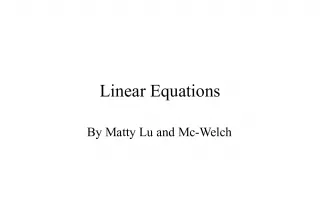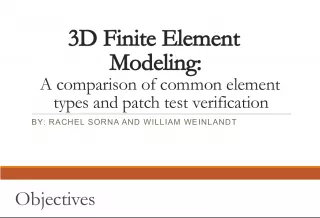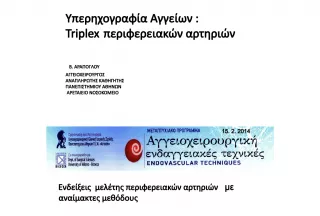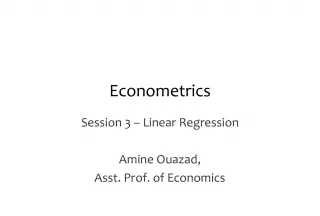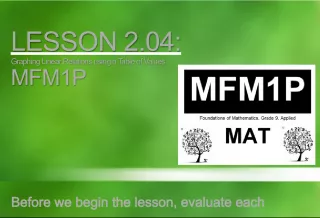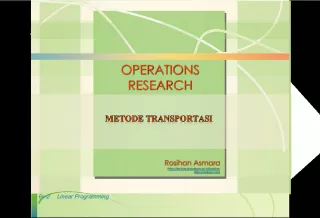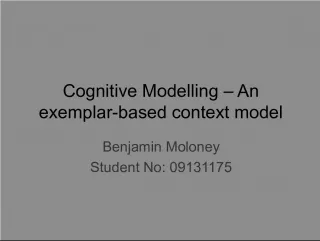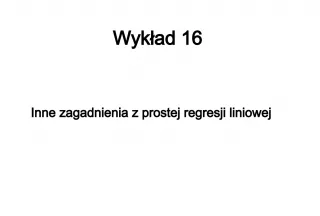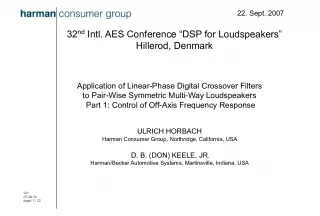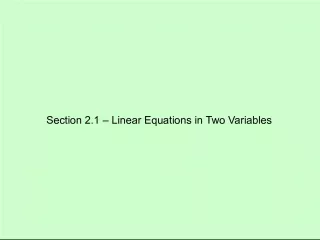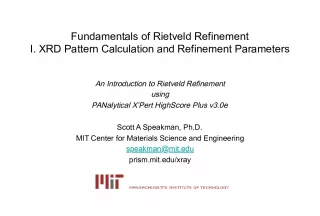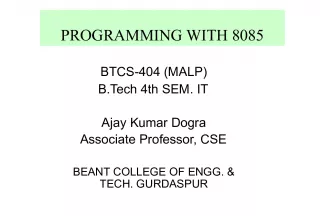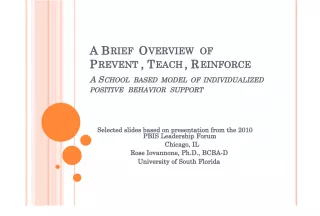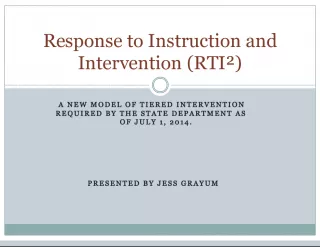Introduction to Generalized Linear Model (GLM)
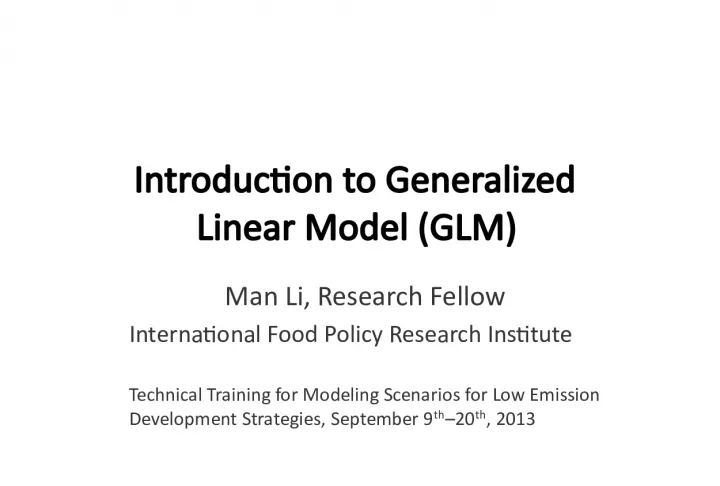

In this technical training for modeling scenarios for low emission development strategies, Man Li, a research fellow at the International Food Policy Research Institute, introduces the concept of the Generalized Linear Model
- Uploaded on | 2 Views
-
 milla
milla
About Introduction to Generalized Linear Model (GLM)
PowerPoint presentation about 'Introduction to Generalized Linear Model (GLM)'. This presentation describes the topic on In this technical training for modeling scenarios for low emission development strategies, Man Li, a research fellow at the International Food Policy Research Institute, introduces the concept of the Generalized Linear Model. The key topics included in this slideshow are . Download this presentation absolutely free.
Presentation Transcript
Slide1Introduction to GeneralizedLinear Model (GLM) Man Li, Research Fellow International Food Policy Research Institute Technical Training for Modeling Scenarios for Low Emission Development Strategies, September 9 th –20 th , 2013
Slide2What is GLM?• In statistics, the GLM is a flexible generalization of ordinary linear (OL) regression that allows for response variable (Y) that other than a normal distribution. • The GLM generalizes linear regression by allowing the linear model to be related Y via a LINK FUNCTION, i.e., E( Y ) = μ = g -1 ( X β ), where g is the link function s.t. g ( μ ) = X β .
Slide3Common distributions with typicaluses and canonical link functions Distribution Support of distribution Typical uses Link name Link function Mean function Normal Real: (- ∞ , + ∞ ) Linear-response data Identify X β = μ μ = X β Bernoulli Integer: [0, 1] Outcome of single yes/no occurrence Logit X β = log( μ /1- μ ) μ = exp( X β )/1 +exp( X β ) Binomial Integer: [0,N] Count of # of “yes” occurrence out of N yes/no occurrences Categorical K-vector of integer: [0, 1] Outcome of single K- way occurrence Similar but a bit complicat ed Similar but a bit complicat ed Multinomial K-vector of integer: [0, N] Count of occurrences of 1-K types out of N total K-way occurrences
Slide4Logit Regression for Binary Responses• Example: Survival and gender in the Donner party―an observational study In 1846 the Donner families left Springfield, Illinois for California by covered wagon. When they reached Fort Bridger, Wyoming in July, the Donner party decided to attempt a new and untested route to the Sacramento Valley. Having reached its full size of 87 people and 20 wagons, the party was delayed in the difficult crossing of the Wasatch Range and again in the crossing of the desert west of the Great Salt Lake. The group became stranded in the eastern Sierra Nevada mountains when hit by heavy snows in late October. By the time the last survivor was rescued on 21 April 1847, 40 of the 87 members had died from famine and exposure to extreme cold.
Slide5Example: Donner Party Deaths• These data were used to study the theory that females are better able to withstand harsh conditions than are males AGE SEX STATUS 23.00 MALE DIED 40.00 FEMALE SURVIVED 40.00 MALE SURVIVED 30.00 MALE DIED 28.00 MALE DIED 40.00 MALE DIED 45.00 FEMALE DIED 62.00 MALE DIED 65.00 MALE DIED 45.00 FEMALE DIED 25.00 FEMALE DIED 28.00 MALE SURVIVED 28.00 MALE DIED 23.00 MALE DIED 22.00 FEMALE SURVIVED 23.00 FEMALE SURVIVED 28.00 MALE SURVIVED 15.00 FEMALE SURVIVED 47.00 FEMALE DIED 57.00 MALE DIED 20.00 FEMALE SURVIVED … … … Ages and sexes of the adult (over 15 years) in the party
Slide6Example: Donner Party Deaths• Question: For a given age, were women more likely to survival than were men? • If linear model: – Y i |X i = X i β (i.i.d) – Y = 1 if survived, = 0 if died – X = (age, sex)
Slide7Ordinary Linear Regression• Fitting model: Y = 0.747 – 0.013*age + 0.319*I [sex=female]
Slide8Ordinary Linear Regression―with Interaction Term • Fitting model: Y = 0.535 – 0.006*age + 1.091*I [sex=female] – 0.025*age*I [sex=female]
Slide9Logit Regression• Model: – Y i |X i ~ Bin(1, π i ) (independent) – g ( π i ) = log( π i /1- π i ) = X i β – Y = 1 if survived, = 0 if died – X = (age, sex) – Null model: log odds of survival = β 0 + β 1 age+ β 2 I [sex=female]
Slide10Possible problems• Logit is not a straight line function of age – Do quadratic age term tests separately for males and females (Wald test) X = (age, agesq) • Slopes are not the same for males and females – Test for the significance of interaction term (Wald test) X = (age, sex, age*sex) – Alternative to Wald: Likelihood ratio test
Slide11Exercise• Open R program code that is located at ftp://ftp.cgiar.org/ifpri/leds2013sep/GLM/GL M_code.R • Load data named “donner” • Define indicator variable “survival” and “sex” • Draw a scatterplot: survival vs. age by gender
Slide12Exercise• Estimate the null model, examine the sign and the p-Value of age and sex variables • Test for the quadratic term of age by gender group • Test for the interaction of sex and age • Draw two fitting plots: the null model and the model with interaction term
Slide13How the Results look like?• H 0 model: log odds of survival = 1.633-0.078*age+1.597*I [sex=female] • H 1 model: log odds of survival = 0.318-0.032*age+6.928*I [sex=female] – 0.025*age*I [sex=female]
Slide14Logit Regression for Multiple Responses• Y i |X i ~ Mult(m i , π 1i , π 2i ,…, π Ki ), ∑ k π ki = 1 Y = 1,2,…,K. (K-category response) • There are K-1 logit models: log( π 1i / π Ki ) = X i β 1 log( π 2i / π Ki ) = X i β 2 … log( π k-1i / π Ki ) = X i β K-1 Note: β K is normalized to be 0 • Rewrite the probabilities Pr(Y i = 1) = exp(X i β 1 )/∑ k exp(X i β k ) Pr(Y i = 2) = exp(X i β 2 )/∑ k exp(X i β k ) … Pr(Y i = K-1) = exp(X i β K-1 )/∑ k exp(X i β k ) Pr(Y i = K) = exp(X i β K )/∑ k exp(X i β k )
Slide15Logit Regression for Multiple Responses
Slide16R Code• multinom() function library(nnet) count.matrix <- cbind(Y1,Y2,…,YK) fit <- multinom(count.matrix ~ X1+X2+…, data=, Hess=True)
Slide17Some Extensions• Conditional logit – X ik is specific to alternative choice, but β does not vary across choice, i.e., X ik β • Nested logit – Can be decomposed into two standard logit • Mixed logit – Integrals of standard logit probabilities over a density of parameters β • See Train (2003) Discrete Choice Methods with Simulation for more discussions

